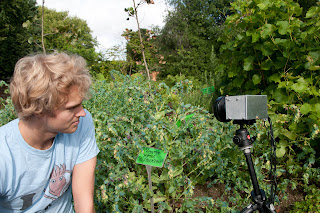One of the many fabulous things about the Botanic Garden is that on any given day, you may find scientists out there conducting cutting edge research. There are currently at least seven research programs going on either directly or indirectly with the garden, making it not only a place of beauty, but also a place of scientific discovery.
I recently had the opportunity to speak with a researcher from the University of Bristol’s Ecology of Vision group, who was in the garden photographing flowers with the most bizarre looking camera. I generally take notice of cameras anyway, but this one could hardly be ignored. It was essentially a metal box perched atop a tripod with a lens protruding out one end and an abundance of wires to connect it to a laptop protruding out the other. It simply begged the question – “what is that and what are you doing with it?”
“It’s a POL camera,” said James Foster, a PhD student in the School of Biological Sciences, “we’re imaging the polarized light reflected off flowers. Humans don’t have polarization vision, so we use this camera to create an image that allows us to see what animals with polarized light sensitivity, such as bees, can see. We want to see what flowers are like from a bee’s point of view.”
If, like me, you aren’t confident in your understanding of polarized light, here are the basics. Light travels as a wave, oscillating as it moves through space. As it travels, the wave can oscillate in any number of orientations, up and down, side to side or any angle in between. Polarization refers to either oscillation orientation of the wave (the angle of polarization) or how many waves oscillate in the same direction (the degree of polarization).
Though humans aren’t sensitive to polarized light, many other species are, including many important plant pollinators such as bees. It’s been known for about 60 years that bees use patterns of polarized light in the sky to navigate, but are they using polarized signals in other aspects of their daily behaviours? This is the question Foster is trying to answer as part of his PhD.
“We know that it’s the upwards facing portion of the bee’s eye that is most sensitive to polarized light, so we’ve been looking specifically at downwards facing flowers,” said Foster. “Those that seem to be most popular with the bees are usually found as clusters on an inflorescence, often where there are less mature flowers at the top and more mature flowers at the bottom. I don’t expect that the bee is using polarized light signals to identify the flower as a flower, but once it gets to the flowers it might be using those signals to optimize its foraging activities. For instance, it could influence the bee’s decision to stay on a lower, more mature flower that may be more depleted in nectar or move quickly up to younger flowers that may have more nectar.”
The research is still in its early stages, but if Foster can demonstrate differences in the polarized signals of mature flowers versus younger flowers that also relate to differences in nectar availability, this will be a first step in determining whether bees are using polarized signals for more than just navigation.
Recent research conducted at the University of Bristol and the University of Cambridge, has shown that conical cells on the surface of the petals of many flowering plants help increase grip for visiting pollinators and are particularly important when the flowers are moving (as they often do in a naturally breezy world).
“Those conical cells would also reduce the degree of polarization of reflections coming off the flower,” added Foster. “What we predict is that there will be areas that will be rich in these conical cells, for gripping, but there will also be regions where the cells are completely flat and these areas will allow polarized reflections that may be important signals for pollinators.”
It’s a tricky thing trying to study a sensory world that we are essentially blind to. However, it probably means that you might see more of James wandering about the garden, POL camera in tow, trying to see the flowers through the eyes of bees.


